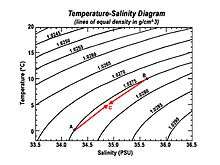Definify.com
Definition 2026
cabbeling
cabbeling
English

A visualization of cabbeling in a sample temperature–salinity diagram. Combining water masses A and B in equal proportions forms water mass C, which has a higher density than either A or B.
Alternative forms
- caballing
- cabbelling (British)
Noun
cabbeling (uncountable)
- (oceanography) The process by which two masses of water with different temperatures and salinities mix to form a new water mass with a density higher than the density of either parent water mass; also, the sinking of the new water mass as the effect of its increased density.
- 1934, Thomas North Whitehead, The Design and Use of Instruments and Accurate Mechanisms: Underlying Principles, New York, N.Y.: Macmillan Co., OCLC 3138109, page 684:
- He reasoned that cabbeling would form a front at the juxtaposition of Warm Deep Water and Shelf Water. Sinking along such a front would thus inhibit the cross shelf flow of shelf water.
- 1982, G. T. Csanady, Circulation in the Coastal Ocean (Environmental Fluid Mechanics; 2), Dordrecht: Springer Netherlands, ISBN 978-90-481-8372-2, page 212:
- To complete this catalog of thermodynamic processes of importance in shallow seas, the phenomenon of cabbeling should be mentioned (from the German ‘Kabbelung’, see Horne et al. (1978), usually pronoun[c]ed in English with the emphasis on the second syllable). Because the equation of state of water is nonlinear, the density of a mixture of two water masses of unequal temperature (and possibly salinity) is greater than the arithmetic average density of the two components. Thus surface mixing of adjacent water masses of differing characteristics generally produces water locally denser than its surroundings, which tends to sink. Sinking motion so generated is referred to as ‘cabbeling’.
- 1994, Chris Garrett, “The Mediterranean Sea as a Climate Test Basin”, in Paola Malanotte-Rizzoli; Allan R. Robinson, editors, Ocean Processes in Climate Dynamics: Global and Mediterranean Examples (Series C: Mathematical and Physical Sciences; 419), Dordrecht: Springer Netherlands, ISBN 978-94-010-4376-2, page 233:
- This effect is presumably compensated for by cabbelling, or densification on mixing, below the surface, but would be interesting to examine in a numerical model.
- 2010, Rui Xin Huang, Ocean Circulation: Wind-Driven and Thermohaline Processes, Cambridge: Cambridge University Press, ISBN 978-0-521-85228-9, page 100:
- When two water parcels with the same mass but different temperature and salinity mix together, the newly generated water parcel may have a density greater than the mean density of the original water parcels. In particular, if the original water parcels have the same density, then the newly formed water parcel may have a density greater than the mean density of the original parcels. As a result, the newly formed water parcel will sink. This process, called cabbeling in oceanography, is due to the nonlinearity of the equation of state of seawater, especially the increase of the thermal expansion coefficient with temperature.
-
References
- ↑ Theodore D. Foster (July 1972), “An Analysis of the Cabbeling Instability in Sea Water”, in Journal of Physical Oceanography, volume 2, issue 3, DOI:, page 296: “Witte thought that the process would be so effective that the sinking would give rise to a rippled or choppy appearance of the sea surface, which in German nautical terminology has been designated "Kabbelung". There is a not very common English cognate "cobbeling" (Webster's Second New International Dictionary) for this word, but the term does not seem to have been generally accepted by oceanographers. There appears to be a great diversity of opinion about the correct spelling of the English word for this mixing process partly, perhaps, due to different opinions concerning the etymology of the word. One opinion is that the word should be spelled "caballing" meaning "to unite in an intrigue" since the two components conspire to form a more dense mixture. Another opinion is that "Kabbelung" should be anglicized to "cabbeling" and can be used to designate the mixing process itself rather than the appearance of a choppy sea surface which was evidently Witte's intention. Rather than introduce a new term we shall follow Stommel (1960, p. 31) and refer to the process as "cabbeling".”
- ↑ E. Witte (1902), “Zur Theorie den Stromkabbelungen”, in Gaea: Natur und Leben, Cologne: E. H. Mayer, OCLC 690995392, pages 484–487.
- ↑ Henry M. Stommel (1960) The Gulf Stream: A Physical and Dynamical Description, Berkeley, Calif.: University of California Press, OCLC 5927886, page 31.
External links
- “cabbeling”, in Meteorology Glossary, American Meteorological Society, 26 January 2012, archived from the original on 12 October 2015.